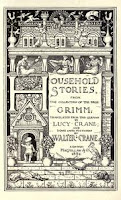On July 28, together with hundreds of Coursera participants from around Northern California, I attended a Meetup at Flood Park in Menlo Park, where we were treated to a lunch of burgers and great conversation with other students AND Ng and Koller and other professors. Again, it felt magical to be a part of this inspiring movement. I met two other women taking the same class I'm enrolled in and many other friendly and eager scholars who are enrolled in a variety of other courses.
If you are even the slightest bit intrigued and/or if you love learning, check out the Coursera website.
 "Fantasy and Science Fiction" is a ten-week course that begins with Grimms' Fairytales (Lucy Crane Translation) and works its way through familiar stories like Adventures in Wonderland, Frankenstein, Dracula, The Invisible Man, and The Martian Chronicles, along with a number of less common titles I look forward to discovering. Each week focuses on a different book or group of stories and culminates with a brief (read VERY pithy) essay. The assignment for the essay (and I LOVE this) is to "enhance the reading of a hypothetical intelligent and attentive fellow student."
"Fantasy and Science Fiction" is a ten-week course that begins with Grimms' Fairytales (Lucy Crane Translation) and works its way through familiar stories like Adventures in Wonderland, Frankenstein, Dracula, The Invisible Man, and The Martian Chronicles, along with a number of less common titles I look forward to discovering. Each week focuses on a different book or group of stories and culminates with a brief (read VERY pithy) essay. The assignment for the essay (and I LOVE this) is to "enhance the reading of a hypothetical intelligent and attentive fellow student."My essay for the Grimm's Fairytale week focused on the irony found in "The Three Spinsters" which actually turned the common fairytale pattern on its head, by giving the "happily ever after" reward to a laggard. In the class, all essays are shared with peers anonymously, but for this venue, I offer my essay below.
Irony Reverses the Pattern
Many fairytales are cautionary stories that deliver fatal
endings to characters who act out their greed, gluttony, envy, or disloyalty.
Other stories hand happily-ever-after treasure or royal weddings to those who
demonstrate loyalty, selflessness, or generosity.
“The Three Spinsters,” an entertaining and humorous story, appears
to make fun of the fairytale pattern itself, when irony is used to unexpectedly
award a happily-ever-after ending to a lazy maiden,
We know the maiden is lazy from the first scene, when her
mother beats her for shirking her spinning duties. The irony begins with the
serendipitous arrival of the queen, a great admirer of the virtue of industry.
To avoid embarrassment, the mother tells the queen the exact opposite of the
truth, that she is beating her daughter because the maiden constantly works too
arduously.
The hand of the prince is offered, unbeknownst to the prince
himself, to the maiden, not for her beauty, as is the fairytale custom, but for
her industry. The maid, of course, must pass a three-fold test requiring her to
spin into thread the mountains of flax filling three rooms in the castle. Also,
of course, she is magically rescued by three very ugly, but very accomplished,
spinsters.
 At the wedding feast, the prince bridegroom, upon meeting the
spinsters and espying their ugliness, asks and is informed that the features of
their ugliness are both the power behind and the result of, their spinning
prowess: large foot (for peddling), large lip (for moistening), and large thumb
(for spinning).
At the wedding feast, the prince bridegroom, upon meeting the
spinsters and espying their ugliness, asks and is informed that the features of
their ugliness are both the power behind and the result of, their spinning
prowess: large foot (for peddling), large lip (for moistening), and large thumb
(for spinning).
Instantly, to preserve the beauty of his bride, known for
her love of spinning, the prince proclaims she shall be forever forbidden from
spinning. Ironically, the lazy maid is rewarded with a handsome prince AND a
spinning-free life of leisure. This ironic twist causes the reader to laugh at
the expense of the fairytale pattern itself.